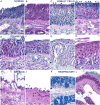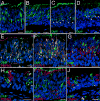Neuropathology of the olfactory mucosa in chronic rhinosinusitis
- PMID: 20021743
- PMCID: PMC5903554
- DOI: 10.2500/ajra.2010.24.3435
Neuropathology of the olfactory mucosa in chronic rhinosinusitis
Abstract
Background: Chronic rhinosinusitis (CRS) is a complex heterogeneous inflammatory disease that affects the nasal cavity, but the pathological examination of the olfactory mucosa (OM) in this disease has been limited.
Methods: Nasal biopsy specimens were obtained from 20 control subjects and 50 CRS patients in conjunction with clinical assessments. Histopathology of these nasal biopsy specimens was performed and immunohistochemistry was used to characterize nonneuronal, neuronal, and inflammatory cells in the OM. These OM characteristics were then evaluated to determine the degree to which pathological features may be related to smell loss in CRS.
Results: Histopathological examination of control and CRS OM revealed changes in the normal pseudostratified olfactory epithelium (OE): intermixing of goblet cells, metaplasia to squamous-like cells, and erosion of the OE. Lower percentages of normal epithelium and olfactory sensory neurons were found in CRS OE compared with controls. Relative to other CRS patients, those with anosmia had the greatest amount of OE erosion, the highest density of eosinophils infiltrating the OE, and exhibited the most extensive abnormalities on CT and endoscopic examination, including being significantly more likely to exhibit nasal polyposis.
Conclusion: Our results suggest that OM pathology observed in nasal biopsy specimens can assist in understanding the degree of epithelial change and sensorineural damage in CRS and the potential for olfactory loss.
Conflict of interest statement
We have no conflict of interest nor have financial disclosure to report.
Figures




Similar articles
-
Analysis of the olfactory mucosa in chronic rhinosinusitis.Ann N Y Acad Sci. 2009 Jul;1170:590-5. doi: 10.1111/j.1749-6632.2009.04364.x. Ann N Y Acad Sci. 2009. PMID: 19686198 Free PMC article.
-
Smoking-associated squamous metaplasia in olfactory mucosa of patients with chronic rhinosinusitis.Toxicol Pathol. 2009 Aug;37(5):594-8. doi: 10.1177/0192623309338055. Epub 2009 Jun 1. Toxicol Pathol. 2009. PMID: 19487255 Free PMC article.
-
The status of the olfactory cleft may predict postoperative olfactory function in chronic rhinosinusitis with nasal polyposis.Am J Rhinol Allergy. 2011 Mar-Apr;25(2):e90-4. doi: 10.2500/ajra.2011.25.3617. Am J Rhinol Allergy. 2011. PMID: 21679509
-
Structures and functions of the normal and injured human olfactory epithelium.Front Neural Circuits. 2024 Jun 6;18:1406218. doi: 10.3389/fncir.2024.1406218. eCollection 2024. Front Neural Circuits. 2024. PMID: 38903957 Free PMC article. Review.
-
Olfactory Dysfunction and Chronic Rhinosinusitis.Immunol Allergy Clin North Am. 2020 May;40(2):223-232. doi: 10.1016/j.iac.2019.12.013. Epub 2020 Jan 16. Immunol Allergy Clin North Am. 2020. PMID: 32278447 Review.
Cited by
-
Type 2 chronic inflammatory diseases: targets, therapies and unmet needs.Nat Rev Drug Discov. 2023 Sep;22(9):743-767. doi: 10.1038/s41573-023-00750-1. Epub 2023 Aug 1. Nat Rev Drug Discov. 2023. PMID: 37528191 Review.
-
[A study on the quality of life and mental health of sinusitis patients with olfactory disorders].Lin Chuang Er Bi Yan Hou Tou Jing Wai Ke Za Zhi. 2020 Feb;34(2):149-152. doi: 10.13201/j.issn.1001-1781.2020.02.012. Lin Chuang Er Bi Yan Hou Tou Jing Wai Ke Za Zhi. 2020. PMID: 32086921 Free PMC article. Chinese.
-
Olfaction: Sensitive indicator of inflammatory burden in chronic rhinosinusitis.Laryngoscope Investig Otolaryngol. 2020 Oct 28;5(6):992-1002. doi: 10.1002/lio2.485. eCollection 2020 Dec. Laryngoscope Investig Otolaryngol. 2020. PMID: 33364387 Free PMC article. Review.
-
Restoration of olfactory dysfunctions by nanomaterials and stem cells-based therapies: Current status and future perspectives.J Tissue Eng. 2022 Mar 23;13:20417314221083414. doi: 10.1177/20417314221083414. eCollection 2022 Jan-Dec. J Tissue Eng. 2022. PMID: 35340424 Free PMC article. Review.
-
Protective Effect of Insulin in Mouse Nasal Mucus Against Olfactory Epithelium Injury.Front Neural Circuits. 2021 Dec 23;15:803769. doi: 10.3389/fncir.2021.803769. eCollection 2021. Front Neural Circuits. 2021. PMID: 35002636 Free PMC article.
References
-
- Cowart BJ, Young IM, Feldman RS, et al. Clinical disorders of smell and taste. Occup Med. 1997;12:465–483. - PubMed
-
- Blackwell DL, Collins JG, Coles R. Summary health statistics for U.S. adults: National Health Interview Survey, 1997. Vital Health Stat 10. 2002:1–109. - PubMed
-
- Benninger MS, Ferguson BJ, Hadley JA, et al. Adult chronic rhinosinusitis: definitions, diagnosis, epidemiology, and pathophysiology. Otolaryngol Head Neck Surg. 2003;129:S1–32. - PubMed
-
- Loury MC, Kennedy DW. Chronic Sinusitis and Nasal Polyposis. In: Getchell TV, Bartoshuk LM, Doty RL, et al., editors. Smell and Taste in Health and Disease. New York: Raven Press; 1991. pp. 517–528.
Publication types
MeSH terms
Grants and funding
LinkOut - more resources
Full Text Sources
Other Literature Sources
Medical

